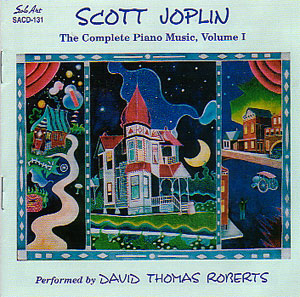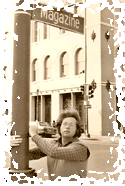Scott Joplin, vol. 1

(Solo Art, New Orleans, LA, 2003 - CD)
Status: Available at JazzByMail
Introduction
The work of ragtime pioneer Scott Joplin (1868-1917) is unique in American culture and remains inadequately understood. Though Joplin’s music underwent an enlightened reassessment in the late 1960s and first half of the ‘70s which brought classic ragtime to a new classical audience, the transformation of academic and general perception of this music remains incomplete. The seriousness and rarified eloquence of Joplin’s oeuvre may continue to elude some observers whose sheer bias against ragtime and/or non-comprehension of late nineteenth century American sensibilities is intractable. But for those whose appreciation of the popular and romantic roots of turn-of-the-century American culture runs deeper, Joplin’s eclectic and highly individual accomplishment is extraordinarily insightful and timelessly precious. He is both akin to American predecessors such as Louis Moreau Gottschalk and Stephen Foster and such European romantics as Frederic Chopin and Robert Schumann. He shares musical territory with contemporaries as dissimilar as John Phillip Sousa and the Brazilian tango pioneer, Ernesto Nazareth. In Scott Joplin’s hands, the syncopated, miniature piano form purveyed in brothels and drawing from quadrilles, schottisches, marches, polkas, habaneras, salon music of all types, banjo tunes, folk songs, minstrelsy and the rhythmic influence of West Africa became a crystalline vehicle for profound self expression.
Though the most basic facts of Joplin’s life are well known, letters, autobiographical documents and intimate anecdotes have not been forthcoming. Born into a musical family in Bowie County, Texas on November 24th, 1868, he became interested in the piano early on, studied with a local German music teacher, and left home in his teens to begin an itinerant life playing in saloons, tent shows and brothels around the Midwest and South. He lived in Sedalia, Missouri during much of the 1890s where he eventually encountered John Stark, who, in 1899 published Maple Leaf Rag, the success of which enabled the composer to leave the deleterious tenderloin performer’s life and settle into teaching and composing in St. Louis. His first opera, A Guest Of Honor, has never surfaced despite claims and rumors to the contrary. A second opera, Treemonisha, composed simultaneously with his later piano pieces, became his single greatest hope for full acceptance as a serious composer. Its doomed first performance in New York in 1915 coincided with his health’s decline due to syphilis, and on April 1st, 1917, he died, as Scott Kirby has written, “in obscurity, madness and despair.” Joplin’s early champion, John Stark, observed his passing most hauntingly: “Here is the genius whose spirit, though diluted, was filtered through thousands of cheap songs and vain imitations.”
Track Listing
- Original Rags (arranged by Charles N. Daniels, 1899). Appearing earlier in the year than Maple Leaf, Original Rags became Joplin's first published ragtime work. Formally looser than his other early rags, it is more akin to folk ragtime in compositional outlook and melodic content. For me, the expressive high point is the trio (a term borrowed from the march denoting the third section), though the 5th and final section sports an earthy character as ideal for closing the piece as it is unusual in Joplin's pantheon.
- Leola – Two Step (1905). Leola is the earliest of three pieces drawing from formal aspects of Maple Leaf Rag (the others are Gladiolus Rag and Sugar Cane). More significantly, it directly forecasts Gladiolus and therefore stands as a crucial component of Joplin's extraordinary middle period.
The first strain is the most telling of Leola's link to both Gladiolus and Maple Leaf, while the second section stands alone in its successive melodic thirds reminiscent of Mediterranean and Latin American styles and may be taken as evidence of the influence of such music upon classic ragtime. The trio and finale represent the composer at his lyrical and bittersweet best. As in Maple Leaf, he returns to the original tonic (A flat) for the final strain, accentuating the sense of resolve and grand purpose, which, in the language of Scott Joplin, is almost invariably mingled with melancholy. - Pleasant Moments – Ragtime Waltz (1909). This ragtime waltz is heard less frequently than the more ambitious Bethena. Uniformly lyrical, fairly light in texture and in rondo form, Pleasant Moments doesn't hint of Bethena’s contrast and poignant drama, but should be taken no less seriously. The melodic use of major 7ths and 6ths in sections 2 and 3 is especially affecting. The Joplin of Pleasant Moments is the Joplin of Country Club, the one who renders innocence as hauntingly as anyone in American music.
- Peacherine Rag (1901). The melodic character of European dance music is particularly evident in the first two sections of this rag. Peacherine's ravishing trio is pure folk ragtime and finds Joplin closer to the world of Charles Hunter than he would ever be again.
- Sunflower Slow Drag – Ragtime Two Step (with Scott Hayden, 1901). It is generally thought that Hayden's material is in the first half (especially the A strain) and that Joplin composed the trio and finale. John Stark, its publisher, admiringly wrote: "If there ever was a song without words, this is the article; hold your ear to the ground while someone plays it, and you can hear Scott Joplin's heart beat."
- Maple Leaf Rag (1899). As the first million-selling sheet music in American history, Maple Leaf Rag was responsible for introducing Scott Joplin to the world. Imitated in countless efforts, it is unquestionably the most influential ragtime composition, and until The Entertainer was popularized by tile film The Sting in 1974, it was Joplin's most familiar title.
Classic ragtime's roots in the march are especially evident in Maple Leaf. Joplin's favorite form, AA BB A CC DD, appears here for the first time in ragtime. The familiar ragtime pattern of alternating octaves and inner voices in the right hand is put to definitive use in the B strain while the "three-over-four" device, which became so familiar several years later, makes one of its earliest appearances in Maple Leaf's trio. - Weeping Willow – A Ragtime Two Step ("Respectfully dedicated to Pawnee Club of St. Louis," 1903). Among the strengths of Joplin's music, sheer melodic appeal and distinction must be ranked first. In Weeping Willow perhaps more than any other work does the composer manage to fashion an autonomous sound-world on the basis of lyrical identity and perfection of relationships between melodic components. It is as if Joplin has found his way into a domain of such rarified meaning that it can only be entered once.
- Bink's Waltz (1905). This unsyncopated piece is an example of how Joplin's musical personality could thrive on grounds independent of ragtime rhythms. The trio is especially personal while reminding us how firmly rooted was the composer in the salon and parlor traditions.
- Elite Syncopations (1902). This work memorably combines melodic beauty with rhythmic propulsion, resulting in a sampling of what Joplin called "that weird and intoxicating effect." Surely nowhere in Joplin's music can be found more intoxication than in the enraptured hoedown that is the final strain.
- The Favorite – A Ragtime Two Step (1904). According to ragtime musician, collector and scholar, Trebor Jay Tichenor, this rag was accepted for publication by A. W. Perry and Sons of Sedalia as early as 1900. The triplets in the opening section are unusual for Joplin, but accentuate the strain's marching character. The B strain is in the relative minor, a practice which the composer would later favor. Overall, The Favorite seems as much band piece as piano rag with its martial character and areas of somewhat unpianistic writing.
- Swipesy – Cake Walk (with Arthur Marshall, 1900). The collaborations stemming from Joplin's friendships with young Arthur Marshall and Scott Hayden of Sedalia, Missouri, remain among his most beloved pieces. In Swipesy, Joplin's imprint is strongest in the gentle trio. Much of the rest seems to be Marshall's, showing considerable similarity to contents of Kinklets and The Pippin.
- Antoinette – March and Two Step (1906). "Respectfully dedicated to Marie Antoinette Williams," this 6/8 march is one of three by Joplin and demonstrates how eloquently the composer handled popular, unsyncopated forms.
- The Nonpareil – A Rag and Two Step (1907). Much admired by the composer's most ardent champions, The Nonpareil looks inward without abandoning the extroverted flavor of ragtime's march roots. In medley-like INTRO AA BB CC DD form, it rolls inevitably toward the lyrical unleashing of the final section, a strain of profound, memory-laden longing presaged by a lullaby-like trio, also of great poignance. This C and D leave the listener with a sense of having been ushered into a realm of unfettered remembering and recounting.
- Gladiolus Rag (1907). Beginning in 1905 with such pieces as Bethena, Leola, and Eugenia, Joplin's interest in writing more dense and overtly romantic music became clear. In Gladiolus Rag, these leanings find their ultimate voice. In live performance I frequently state that, when considering the pieces exemplifying the achievement of Scott Joplin, this one comes to mind first.
Bars 1-4 of the A section are akin to Leola's whereas bars 5-16 reflect the same area of Maple Leaf in phrasing though the spirit of this music, at once melancholy and coy, dwells far down the road from the earlier piece. The B strain unfolds very naturally from the A, highlighting the introductory nature of the Maple Leaf-derived material. The trio is immediately memorable for its solemn, Germanic chromaticism, the likes of which we find in shorter instances elsewhere in Joplin. Marked grandioso, the finale marshals the full force of Joplin's romantic Americana to give utterance to the composer's most revealing sentiments and ideals. For good measure, it concludes with the same cadence as the trio's, a practice found in many of his greatest pieces. - The Easy Winners – A Ragtime Two Step (1901). Reported to have been the composer's favorite of his works, The Easy Winners embodies the motivically-based seamlessness which Joplin brought to ragtime. It was the first of his self-published rags. As in Sunflower Slow Drag and Weeping Willow, the trio section's closing bars also conclude the final strain. The last section possesses an audacious playfulness and insistence unique to The Easy Winners, but which looks toward such delirious music as the finale of Rose Leaf Rag.

